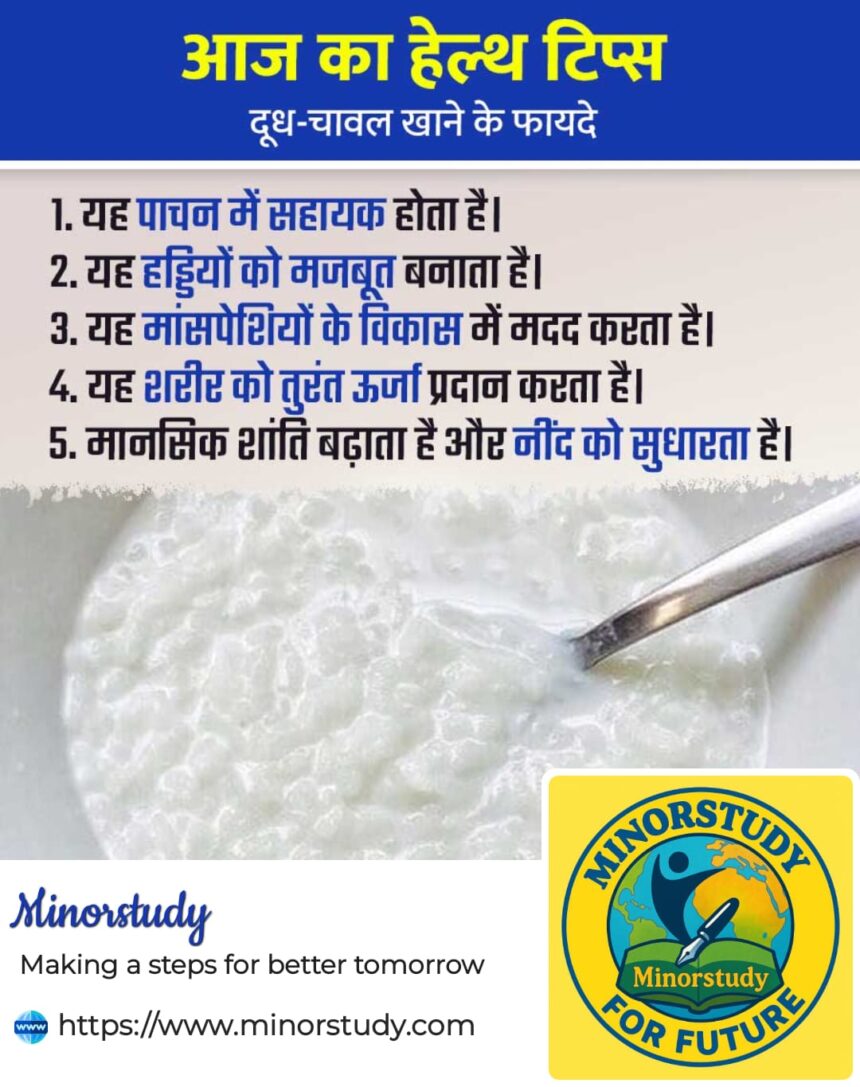🍚 5 Powerful Reasons Why Milk Rice Is a Delicious Blessing for Your Health and Mind
In our fast-paced modern lives, simple, traditional foods often hold the deepest healing powers. One such timeless recipe is the humble yet nourishing milk rice — known in India as “Kheer,” “Doodh Bhaat,” or “Paayasam”, depending on the region.
- 🧾 What is Milk Rice?
- 📜 History of Milk Rice
- 📅 Timeline: Evolution of Milk Rice
- 🌟 5 Proven Health Benefits of Eating Milk Rice
- 1. 🦴 Strengthens Bones
- 2. 💪 Aids in Muscle Development
- 3. ⚡ Provides Instant Energy
- 4. 🧘 Improves Sleep and Mental Calmness
- 5. 🦠 Supports Gut Health
- ❓FAQs on Milk Rice
- ❓Can milk rice be eaten daily?
- ❓Is it good for children?
- ❓Can lactose-intolerant people eat it?
- ❓Does it help in recovery after illness?
- ❓Is it good during fasting?
- 🔎 Cultural and Religious Significance
- 🌍 Daily Life Impact of Including Milk Rice
- ✨ Important Points to Remember
- 💬 Beautiful Wishes to Share
- 🌈 Why Milk Rice Matters in Modern Life
- 🏁 Conclusion: A Simple Bowl with Powerful Goodness
This classic comfort food is not only a cultural staple but also a nutritional powerhouse. Whether enjoyed as breakfast, prasad (offering), or dinner during fasting days, milk rice is a gift of taste, tradition, and wellness rolled into one warm, fragrant bowl.
Let’s dive into its rich history, scientific benefits, and how you can bring this soothing food into your daily life with awareness and joy.
🧾 What is Milk Rice?
Milk rice is a simple dish made by simmering rice in milk, often sweetened with sugar or jaggery and flavored with cardamom, saffron, or dry fruits. It can be both a savory and sweet dish depending on regional preferences.
🌾 Main ingredients: Milk, rice, and natural sweeteners
🍽️ Other add-ons: Dry fruits, ghee, cardamom, saffron, nutmeg, jaggery
From Ayurveda to modern nutrition, this dish has been revered for centuries due to its digestive, calming, and energy-boosting qualities.
📜 History of Milk Rice
Ancient roots: Traced back to Vedic India, milk and rice have long been offered to deities during yajnas and rituals.
Ayurveda: Recommends milk-rice as balya (strength-giving) and brimhana (nourishing) food.
Religious relevance: Offered as prasadam in temples, especially in South India and Bengal.
Global reach: Variants of milk rice exist across the world — from Indian kheer to Thai sticky rice with coconut milk to Spanish arroz con leche.
It has stood the test of time, thanks to its healing nature and spiritual significance.
📅 Timeline: Evolution of Milk Rice
| Period | Event |
|---|---|
| 1500 BCE | Mentioned in ancient Ayurvedic texts as a sattvic dish |
| 1000 BCE | Used as sacred food in rituals in Vedic India |
| 600 CE | Became a festive offering in Hinduism, Buddhism, and Jainism |
| Medieval period | Refined with dry fruits and saffron in royal kitchens |
| Present day | Popular in modern Ayurveda, health routines, and fasting |
🌟 5 Proven Health Benefits of Eating Milk Rice
1. 🦴 Strengthens Bones
Milk is a natural source of calcium and vitamin D, while rice provides magnesium and phosphorus — all crucial for bone health.
It helps prevent osteoporosis, especially in women and elderly people.
2. 💪 Aids in Muscle Development
Rice offers complex carbohydrates and milk delivers complete proteins, which support muscle repair and growth — ideal for kids, fitness lovers, and recovering patients.
3. ⚡ Provides Instant Energy
The glucose from rice and lactose from milk provide quick energy, making it a great food choice for fatigue, post-illness recovery, or after physical exertion.
4. 🧘 Improves Sleep and Mental Calmness
Warm milk rice is naturally sattvic, calming the nervous system. Tryptophan in milk helps promote melatonin production, aiding in deeper and quality sleep.
5. 🦠 Supports Gut Health
The blend of soft rice and warm milk is light on digestion and may soothe gastric inflammation. It’s often given during fever, diarrhea, or indigestion.
❓FAQs on Milk Rice
❓Can milk rice be eaten daily?
Yes! If prepared with minimal sugar and healthy ingredients, milk rice can be eaten as a light dinner or breakfast frequently.
❓Is it good for children?
Absolutely. It’s a nutrient-rich meal that helps in physical and cognitive development of growing children.
❓Can lactose-intolerant people eat it?
For them, lactose-free milk or plant-based alternatives like coconut or almond milk can be used.
❓Does it help in recovery after illness?
Yes, due to its soft, digestible nature and instant energy boost, it’s excellent for people recovering from fever, weakness, or stress.
❓Is it good during fasting?
Definitely. Milk rice is often consumed during Navratri, Ekadashi, and Sawan Mondays as a wholesome and spiritual meal.
🔎 Cultural and Religious Significance
🙏 Offered as bhog in temples and rituals
🛕 Popular during festivals like Janmashtami, Navratri, Pongal, and Purnima
📿 Considered sattvic, ideal for meditation and puja
🤱 Given to mothers during postpartum care in Ayurvedic tradition
🎉 Served as a symbol of prosperity in weddings and housewarming rituals
🌍 Daily Life Impact of Including Milk Rice
| Area of Life | Positive Impact |
|---|---|
| 👨👩👧👦 Family Health | Safe for all ages, from toddlers to elders |
| 🧘 Spiritual Balance | Calms the mind, improves focus and meditation |
| 🍴 Diet Simplicity | Wholesome one-pot meal, easy to digest and prepare |
| 🕯️ Fasting Days | Satisfying and spiritually aligned food option |
| 🛌 Better Sleep | Soothes anxiety and supports nighttime rest |
✨ Important Points to Remember
Avoid overuse of sugar; try jaggery or dates instead
Consume warm for best benefits
Best eaten during morning or evening for calming effect
Avoid eating with sour fruits or heavy spices
Add cardamom, dry fruits, or saffron for enhanced taste and health value
💬 Beautiful Wishes to Share
🌼 “May your day be as pure and nourishing as a bowl of milk rice – full of peace, warmth, and healing.”
💫 “On this blessed Saturday, choose simplicity, choose milk rice — a gift from tradition to your health.”
🕊️ “Let the sattvic goodness of doodh-bhaat fill your body with strength and your soul with calm.”
🌈 Why Milk Rice Matters in Modern Life
In the age of protein shakes and processed foods, milk rice offers ancient comfort in a rapidly changing world. Its spiritual simplicity, gentle digestion, and restorative powers make it a holistic food — ideal for modern stresses, sleep issues, and immunity building.
When prepared with awareness and love, milk rice becomes more than just a dish — it becomes nourishment for the soul.
🏁 Conclusion: A Simple Bowl with Powerful Goodness
Milk rice is proof that good health doesn’t need to be complicated. With just a few ingredients and a warm heart, you can prepare a meal that is:
✅ Nutritionally balanced
✅ Spiritually calming
✅ Easy to digest
✅ Full of cultural heritage
“Sometimes, the best health remedy is not in a bottle, but in a bowl of milk and rice served with love.”








